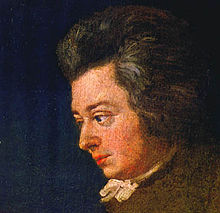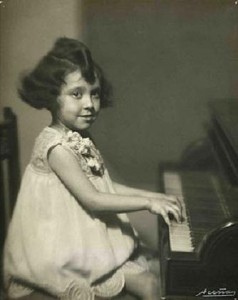 Four years ago I wrote a Wall Street Journal “Sightings” column about what has come to be known in this country as “the 10,000-hour rule”:
Four years ago I wrote a Wall Street Journal “Sightings” column about what has come to be known in this country as “the 10,000-hour rule”:
The theory is known in England as “the 10-year rule” and in the U.S., where it has been popularized by Malcolm Gladwell, the author of “Outliers,” as “the 10,000-hour rule.” The premise is the same: To become successful at anything, you must spend 10 years working at it for 20 hours each week. Do so, however, and success is all but inevitable. You don’t have to be a genius—in fact, there’s no such thing.
K. Anders Ericsson, the psychologist who is widely credited with having formulated the 10,000-hour rule, says in “The Making of an Expert,” a 2007 article summarizing his research, that “experts are always made, not born.” He discounts the role played by innate talent, citing Wolfgang Amadeus Mozart as an example: “Nobody questions that Mozart’s achievements were extraordinary…What’s often forgotten, however, is that his development was equally exceptional for his time. His musical tutelage started before he was four years old, and his father, also a skilled composer, was a famous music teacher and had written one of the first books on violin instruction. Like other world-class performers, Mozart was not born an expert—he became one.”
It’s easy to see why the Ericsson-Gladwell view of genius as a form of skill-based expertise has become so popular, for it meshes neatly with today’s egalitarian notions of human potential. Moreover, there is much evidence for the validity—up to a point—of the 10,000-hour rule. My own favorite example is that of Charlie Parker, the father of bebop. As a teenager, Parker embarrassed himself by sitting in at Kansas City jam sessions before he had fully mastered the alto saxophone, thereby acquiring a city-wide reputation for incompetence. In 1937 the humiliation overwhelmed him, and he took a summer job at a Missouri resort and began practicing in earnest for the first time in his life. Eight years later, he had metamorphosed into the glittering virtuoso who teamed up with Dizzy Gillespie to record “Ko-Ko,” “Groovin’ High” and “Salt Peanuts,” thereby writing himself into the history of jazz.
The problem with the 10,000-hour rule is that many of its most ardent proponents are political ideologues who see the existence of genius as an affront to their vision of human equality, and will do anything to explain it away. They have a lot of explaining to do, starting with the case of Mozart….
Nannerl, Mozart’s older sister, was a gifted pianist who received the same intensive training as her better-known brother, yet failed to develop as a composer. What stopped her? The simplest explanation is also the most persuasive one: He had something to say and she didn’t. Or, to put it even more bluntly, he was a genius and she wasn’t.
I thought of this column the other day when Mark Ainley posted on his Facebook page a YouTube video of a recording of Chopin’s B Major Nocturne, Op. 32, No. 1, by Alicia de Larrocha, the great Spanish pianist:
It’s an exquisite performance, immaculate and sensitive—and it was recorded in 1932, when she was nine years old.
Nor was de Larrocha thrust headlong and unwillingly into the crushing vise of premature hard work that made such a performance possible. Instead, she insisted on it. According to Allan Kozinn’s 2009 New York Times obituary:
Ms. de Larrocha began to demand piano lessons when she was 3, after visiting her aunt as she taught students. At the keyboard on her own, Ms. de Larrocha imitated what she had seen her aunt’s students do, and impressed her aunt sufficiently that she took Ms. de Larrocha to Marshall [Frank Marshall, her first piano teacher]. He was less encouraging. He said it was too early to start lessons, and suggested that Ms. de Larrocha be kept away from the piano. Ms. de Larrocha said that once her aunt locked the instrument, she banged her head on the floor until Marshall relented and began to teach her.
She made progress quickly. At 5 she made her concert debut, performing works by Bach and Mozart at the 1929 International Exhibition in Barcelona. She made her orchestral debut with a Mozart concerto in Madrid when she was 11.
 Of course she received first-class training—Marshall was a distinguished pianist in his own right—and you can bet that she practiced a lot, too. But when it comes to art, practice alone doesn’t make perfect. Most of the time, in fact, it doesn’t make anything at all. It is nothing more than the enabling condition that permits innate talent to flower, and in the absence of that talent, nothing happens.
Of course she received first-class training—Marshall was a distinguished pianist in his own right—and you can bet that she practiced a lot, too. But when it comes to art, practice alone doesn’t make perfect. Most of the time, in fact, it doesn’t make anything at all. It is nothing more than the enabling condition that permits innate talent to flower, and in the absence of that talent, nothing happens.
I spoke in my 2010 column of “the impenetrable mystery that enshrouds such birds of paradise as Bobby Fischer, who started playing chess at the age of six. Nine years later, he became the U.S. chess champion. His explanation? ‘All of a sudden I got good.’” As much as some people hate to admit it, it can happen just like that. But hate it they do, just as other people hate any kind of ultimately inexplicable phenomenon, preferring a mystery-free world where everything makes sense and anyone can be a genius. And who shall blame them? On such naïve optimism is much, perhaps most of our daily drudgery based. Perhaps only the artist knows better.
Orson Welles said it: “The optimists are incapable of understanding what it means to adore the impossible.”
